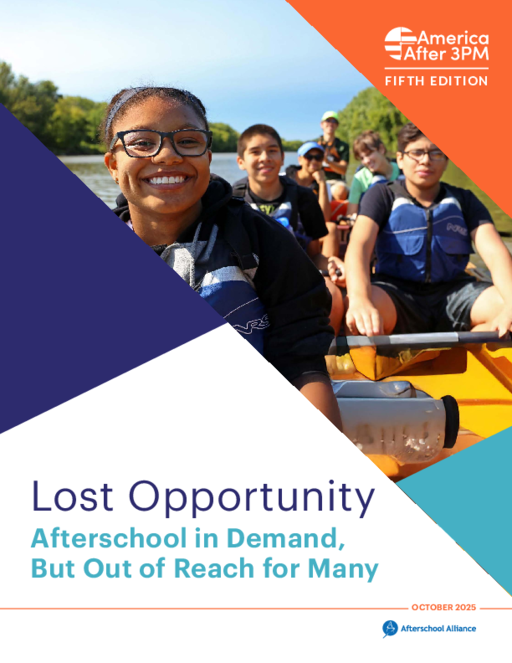Breadcrumb
- Wallace
- Reports
- Lost Opportunity Afterschool In ...
Lost Opportunity
Afterschool in Demand, But Out of Reach for Many

Summary
How we did this
Researchers surveyed over 30,000 parents and legal guardians with at least one school-aged child in their home and completed at least 200 interviews in all 50 states and Washington D.C.
High-quality afterschool programs play a vital role in children’s development by offering safe, supportive spaces where students can continue to learn, grow, and thrive after the school day. However, despite the rising demand among parents for afterschool programs, these opportunities remain out of reach for many families.
The fifth edition of America After 3PM, published by the Afterschool Alliance, dives into the unmet demand for afterschool programs and provides new insights into the activities of U.S. children between 3 p.m. and 6 p.m through a survey of over 30,000 parents and guardians across the country. This is the first large-scale report focused on afterschool since the COVID-19 pandemic.
The survey found that:
- Parents of almost 30 million kids—more than half the country’s school-age youth—want afterschool programs for their children. Yet over 75 percent of these children do not have access to programming. Unmet demand for afterschool programs is highest for children in low- and middle-income families.
- Parents identified affordability, accessibility, and availability as key barriers to participation in afterschool programs.
- The gap between what families with high incomes spend on out-of-school time compared with low-income families has expanded, with higher-income families spending nine times more.
- Parents agree that afterschool programs keep children safe and provide an array of benefits, such as helping build skills, improve school attendance, and more.
- More than 80 percent of respondents said that afterschool helps them maintain employment, boost their productivity, and reduce stress.
- 95 percent of parents reported overall satisfaction with their afterschool programs.
For more information and resources, visit America After 3PM. America After 3PM 2025 was made possible through partnership with the New York Life Foundation.

Programs get youth excited about learning, boost school attendance, provide opportunities for them to connect with peers and mentors, and help develop their skills, including teamwork, critical thinking, and leadership.
Key Takeaways
- Demand for afterschool programs among parents is high. However, most families cannot access them due to barriers to participation such as affordability, accessibility, and availability.
- Parents see many benefits of afterschool programming, such as providing kids with opportunities to stay active; develop skills like teamwork, critical thinking, and leadership; and become more excited about learning.
- The gap between spending on out-of-school-time activities by families with high and low incomes has grown significantly in the last five years.
- Support for afterschool programming remains high—89 percent of parents support public funding for afterschool and parent satisfaction with programs has reached 95 percent.
- Respondents across the political spectrum support public funding for afterschool programs.
Visualizations




